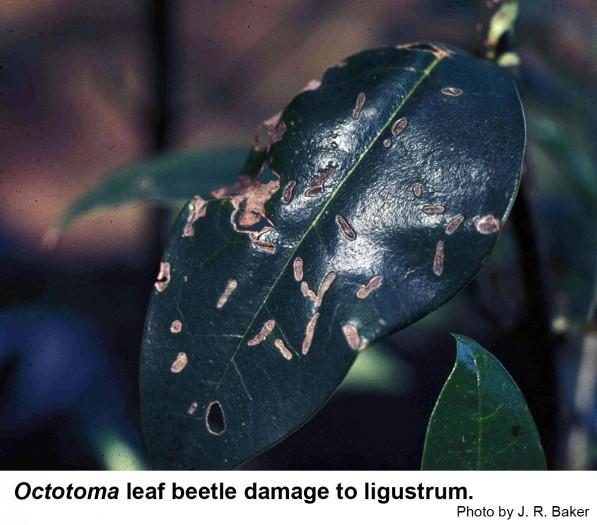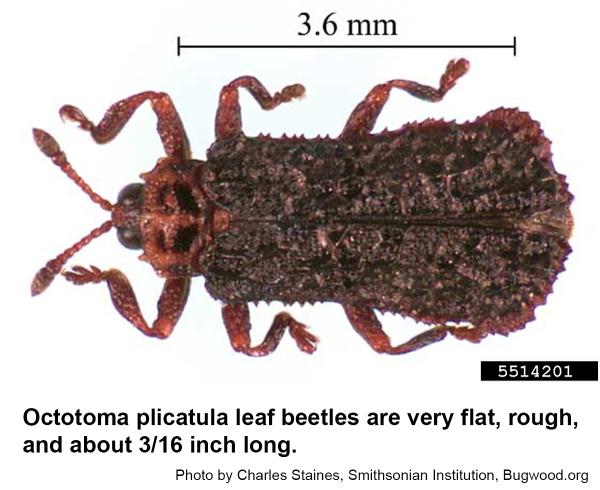Description and Biology
The octotoma leaf beetle, Octotoma plicatula, was described by Fabricius in 1801 based on a beetle collected in “Carolina.” It is a brown to black, wedge-shaped, flattened beetle about 3/16 inches long. The upper surface is rough with bumps and ridges. Adults are active from May through August. The larvae are leaf miners in cow itch, Campsis radicans, and lespedeza. In the leaves of cow itch, the larvae form winding mines, and excrement collects as a black spot at one end of the mine, usually toward the midrib or base of the leaves. They pupate inside the mines and the adults emerge sometime later. The pupae have unusual spines associated with the spiracles of abdominal segments 3, 4, and 5. Octotoma Leaf Beetle. The beetles chew long, narrow patches from the lower surface of leaves up to 13/16 inches long. These patches are often crescent shaped. Heavily damaged leaves may drop prematurely.
Host Plants
Octotoma leaf beetles feed on the leaves of ash, fringe tree, horse chestnut, and ligustrum. Adults have been reported from carrot flowers as well. Octotoma leaf beetles chew long, narrow, sometimes crescent shaped patches from the lower surface of leaves. Heavily damaged leaves may drop prematurely.
Residential Recommendation
This beetle should not be resistant to pesticides, so just about any insecticide labeled for landscape use in home grounds should give more than adequate control.
References
- Larvae of Donacia. Sanderson, E. D. Canadian Entomologist 32(9): 249-263
- A Revision of the Genus Octotoma (Coleoptera: Chrysomelidae, Hispinae). Staines, C. L. 1989. Insecta Mundi, Paper 474. pp. 41-56.
- Extension Plant Pathology Publications and Factsheets
- Horticultural Science Publications
- North Carolina Agricultural Chemicals Manual
For assistance with a specific problem, contact your local N.C. Cooperative Extension Center.
This Factsheet has not been peer reviewed.
Publication date: June 3, 2013
Reviewed/Revised: May 8, 2023
Recommendations for the use of agricultural chemicals are included in this publication as a convenience to the reader. The use of brand names and any mention or listing of commercial products or services in this publication does not imply endorsement by NC State University or N.C. A&T State University nor discrimination against similar products or services not mentioned. Individuals who use agricultural chemicals are responsible for ensuring that the intended use complies with current regulations and conforms to the product label. Be sure to obtain current information about usage regulations and examine a current product label before applying any chemical. For assistance, contact your local N.C. Cooperative Extension county center.
N.C. Cooperative Extension prohibits discrimination and harassment regardless of age, color, disability, family and marital status, gender identity, national origin, political beliefs, race, religion, sex (including pregnancy), sexual orientation and veteran status.



